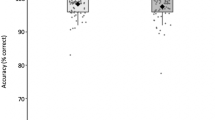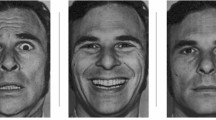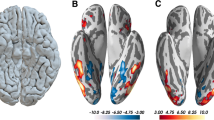Abstract
Prosopagnosia is the inability to recognize someone by the face alone in the absence of sensory or intellectual impairment. In contrast to the acquired form of prosopagnosia we studied the congenital form. Since we could recently show that this form is inherited as a simple monogenic trait we called it hereditary form. To determine whether not only face recognition and neuronal processing but also the perceptual acquisition of facial information is specific to prosopagnosia, we studied the gaze behaviour of four hereditary prosopagnosics in comparison to matched control subjects. This rarely studied form of prosopagnosia ensures that deficits are limited to face recognition. Whereas the control participants focused their gaze on the central facial features, the hereditary prosopagnosics showed a significantly different gaze behaviour. They had a more dispersed gaze and also fixated external facial features. Thus, the face recognition impairment of the hereditary prosopagnosics is reflected in their gaze behaviour.




Similar content being viewed by others
References
Antes, J. R. (1974). The time course of picture viewing. Journal of Experimental Psychology, 103, 62–70.
Ariel, R., & Sadeh, M. (1996). Congenital visual agnosia and prosopagnosia in a child: A case report. Cortex, 32, 221–240.
Barton, J. J. S., Press, D. Z., Keenan, J. P., & O’Connor, M. (2002). Lesions of the fusiform face area impair perception of facial configuration in prosopagnosia. Neurology, 58, 71–78.
Bentin, S., Deouell, L. Y., & Soroker, N. (1999). Selective visual streaming in face recognition: Evidence from developmental prosopagnosia. Neuroreport, 10, 823–827.
Behrmann, M., & Avidan, G. (2005). Congenital prosopagnosia: Face-blind from birth. Trends in Cognitive Science, 9, 180–187.
Benton, A. (1990). Facial recognition. Cortex, 26, 491–499.
Bodamer, J. (1947). Die Prosop-Agnosie. Archiv für Psychiatrie und Nervenkrankheiten, 179, 6–53.
Bruce, V. (1988). Recognizing faces. Hillsdale: Erlbaum.
Bruce, V., & Young, A. (1998). In the eye of the beholder. Oxford: Oxford University Press.
Campbell, R., Walker, J., & Baron, C. S. (1995). The development of differential use of inner and outer face features in familiar face identification. Journal of Experimental Child Psychology, 59, 196–210.
Carey, S. (1996). Perceptual classification and expertise. In R. Gelman, & T. Kit-Fong Au (Eds.). Perceptual and cognitive development (pp. 49–69). San Diego: Academic.
Carmody, D. P., Nodine, C. F., & Kundel, H. L. (1980). Global and segmented search for lung nodules of different edge gradients. Investigative Radiology, 15, 224–233.
Choisser, B. http://www.choisser.com/faceblind/.
De Gelder, B., & Rouw, R. (2000). Configural face processes in acquired and developmental prosopagnosia: Evidence for two seperate face systems? Neuroreport, 11, 3145–3150.
De Haan, E. H. F. (1999). A familial factor in the development of face recognition deficits. Journal of Clinical and Experimental Neuropsychology, 21, 312–315.
De Haan, E. H., & Campbell, R. (1991). A fifteen year follow-up of a case of developmental prosopagnosia. Cortex, 27(4), 489–509.
Duchaine, B. C. (2000). Developmental prosopagnosia with normal configural processing. Neuroreport, 11, 79–83.
Duchaine, B. C., Parker, H., & Nakayama, K. (2003). Normal recognition of emotion in a prosopagnosic. Perception, 32, 827–838.
Grüter, M. (2004). Genetik der Prosopagnosie. Dissertation. Rheinisch Westfälische Wilhelms-Universität, Münster, Germany.
Grüter, M., Grüter, T., Bell, V., Horst, J., Laskowski, W., Sperling, K., et al. (in press). Hereditary prosopagnosia: The first case series. Cortex.
Hadjikhani, N., & De Gelder, B. (2002). Neural basis of prosopagnosia: An fMRI study. Human Brain Mapping, 16, 176–182.
Hasson, U., Avidan, G., Deouell, L., Bentin, S., & Malach, R. (2003). Face-selective activation in a congenital prosopagnosic subject. Journal of Cognitive Neuroscience, 15, 419–431.
Henderson, J. M., Falk, R., Minut, S., Dyer, F. C., & Mahadevan, S. (2001). Gaze control for face learning and recognition in humans, machines. In T. Shipley & P. Kellman (Eds.) From fragments to objects: Segmentation processes in vision (pp. 463–481). New York: Elsevier.
Janik, S. W., Wellens, A. R., Goldberg, M. L., & Dell’Osso, L. F. (1978). Eyes as the center of focus in the visual examination of human faces. Perceptual and Motor Skills, 47, 857–858.
Jones, R. D., & Tranel, D. (2001). Severe developmental prosopagnosia in a child with superior intellect. Journal of Clinical and Experimental Neuropsychology, 23, 265–273.
Kennerknecht, I., Grüter, M., Grüter, T., Otte, S., Neumann T., Meyer B., et al. (2002). First report on the genetics of prosopagnosia. European Journal of Human Genetics, 10(Suppl. 1), 249.
Kress, T., & Daum, I. (2003). Event-related potentials reflect impaired face recognition in patients with congenital prosopagnosia. Neuroscience Letters, 352, 133–136.
Kundel, H. L., & Nodine, C. F. (1983). A visual concept shapes image perception. Radiology, 146, 363–368.
Le, S., Raufaste, E., & Demonet, J. (2003). Processing of normal, inverted, and scrambled faces in a patient with prosopagnosia: behavioural and eye tracking data. Cognitive Brain Research, 17, 26–35.
Manor, B. R., Gordon, E., Williams, L. M., Rennie, C. J., Bahramali, H., Latimer C. R., et al. (1999). Eye movements reflect impaired face processing in patients with schizophrenia. Biological Psychiatry, 46, 963–969.
McConachie, H. R. (1976). Developmental prosopagnosia: a single case report. Cortex, 12, 76–82.
Nunn, J. A., Postma, P., & Pearson, R. (2001). Developmental prosopagnosia: Should it be taken at face value? Neurocase, 7, 15–27.
Oliveira, L. F., Simpson, D. M., & Nadal, J. (1996). Calculation of area of stabilometric signals using principal component analysis. Physiological Measurement, 17, 305–312.
Pelphrey, K. A., Sasson N. J., Reznick J. S., Paul G., Goldman B. D., & Piven J. (2002). Visual scanning of faces in autism. Journal of Autism and Developmental Disorders, 32, 249–261.
PICS. Psychological Image Collection at Stirling, University of Stirling, Psychology Department, http://www.pics.psych.stir.ac.uk/ (access May 2002).
Rizzo, M., Hurtig, R., & Damasio, A. R. (1987). The role of scanpaths in facial recognition and learning. Annals of Neurology, 22, 41–45.
Schwarzer, G., Huber, S., & Dümmler, T. (2005). Gaze behaviour in analytical and holistic face processing. Memory & Cognition, 33, 344–354.
Stark, L., & Ellis, S. R. (1981). Scanpath revisited: Cognitive models of direct active looking. In D. F. Fisher, R. A. Monty, & J. W. Senders (Eds.) Gaze behavior: Cognition and visual perception (pp. 193–226). Hillsdale, NJ: Lawrence Erlbaum.
Temple C. M. (1992). Developmental memory impairment: faces and patterns. In R. Campbell (Ed.). Mental lives: case studies in cognition (pp. 199–215). Oxford: Blackwell.
Viviani P. (1990). Gaze behavior into visual search. Cognitive, perceptual and motor control aspects. In E. Kowler (Ed.). Gaze behavior and their role in visual and cognitive processes (pp. 353–393). Amsterdam: Elsevier.
Walker-Smith, G. J., Gale, A. G., & Findlay, J. M. (1977). Eye movement strategies involved in face perception. Perception, 6, 313–326.
Yarbus, A. L. (1967). Eye movements and vision. New York: Plenum.
Author information
Authors and Affiliations
Corresponding author
Appendix
Appendix
Faces used in the famous face task
-
Boris Becker
-
Norbert Blüm
-
George Bush
-
Sabine Christiansen
-
Bill Clinton
-
Gerard Depardieu
-
Lady Diana
-
Albert Einstein
-
Joschka Fischer
-
Greta Garbo
-
Thomas Gottschalk
-
Günther Grass
-
Gregor Gysi
-
Günther Jauch
-
Helmut Kohl
-
Oskar Lafontaine
-
Elvis Pressly
-
Claudia Roth
-
Gerhard Schröder
-
Ralf Schumacher
-
Jürgen Trittin
-
Theodor Waigel
-
Richard von Weizäcker
-
Ulrich Wickert
Rights and permissions
About this article
Cite this article
Schwarzer, G., Huber, S., Grüter, M. et al. Gaze behaviour in hereditary prosopagnosia. Psychological Research 71, 583–590 (2007). https://doi.org/10.1007/s00426-006-0068-0
Received:
Accepted:
Published:
Issue Date:
DOI: https://doi.org/10.1007/s00426-006-0068-0




